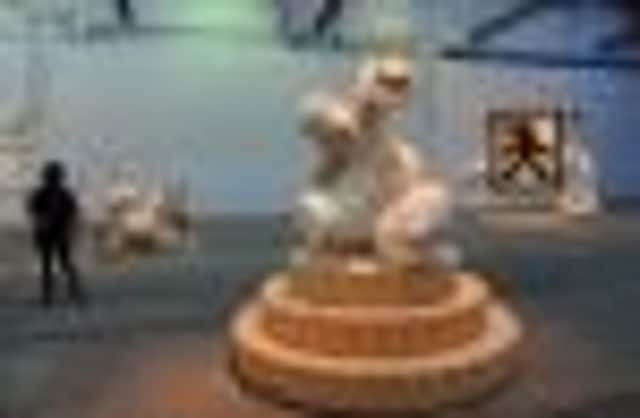Nick Evans’ sculptures at Glasgow’s Tramway


Nevertheless the elaborate temple-like structure he has built to house his sculpture, with its cheeky references to both Mayan and Egyptian pyramids, can’t help but bring to mind that – despite what everyone on Twitter predicted – the world didn’t end recently.
Of course, experts told us the whole scare was nonsense all along. Why do we wilfully misread the history of ancient cultures? Sometimes, perhaps, because we are burdened with the blinkers of racism, stupidity or colonialism. Sometimes because history is truly lost to us. But often, as I suspect in the case of the Mayans, just because it’s fun.
Advertisement
Hide AdFor artists, the near electric charge of the encounter with other civilisations – people whose art seems quicker and fiercer, more succinct or much more subtle than the dusty old museums of Europe – has driven hundreds of years of art-making and thinking.
There’s been honest study and wilful misappropriation. Nick Evans, a Glasgow sculptor, sits somewhere knowingly in this mix. His kitsch but compelling conceit for Solar Eyes, the biggest show of his work to date, is a series of encounters with artworks set in a thick-walled chamber and displayed in increasingly extravagant manners. It’s like entering an ancient tomb and encountering mysterious artefacts from a lost civilisation.
The sculptures themselves will be familiar to anyone who has seen Evans’ recent work. They are dumpy plaster forms, like Henry Moores that have only half-hatched from their shells, or half-baked Barbara Hepworths. They are semi-human, with their drooping pendulous bits or pert appendages. And often they are cut off at the limbs, like the dusty classical statuary they affectionately mock.
At Tramway, these basic forms are dressed in funny new references. The first figure that greets you has huge eyes made from concentric black and white circles. There seem to be obvious links to Niki de Saint Phalle’s “nana” figures, rotund little female goddesses currently on show at Glasgow’s GoMA.
And there are multiple references to Neolithic goddess worship, including that of Avebury, the English site that has been the centre of centuries-long speculation about ancient rites.
The suggestion seems to be that the struggle to make sense or meaning out of exotic cultures, whether that is daftness about the Mayans, or our own distance from the civilisations that built ancient sites in Britain, is not shameful but a genuine encounter.
Advertisement
Hide AdIt’s a quandary that Evans extends to his own art; all this goddess worship is like a secret vice of sculptors, it ensnared Henry Moore and now it’s got Evans by the short and curlies.
Along the way there are many comic encounters. Working with artist Charlie Hammond, Evans has created a dining table complete with half-eaten ceramic food. It puts one in mind of an abandoned meal table at Pompeii. But examining the contents is a little gruesome. The pottery peas are cute, but is that spaghetti or human entrails? I’m sure I spotted an eyeball.
Advertisement
Hide AdThese suggestions of human sacrifice are also, surely, a little essay on Claude Lévi-Strauss’s famous work The Raw And The Cooked, which suggested that certain mythologies are consistent across widely divergent cultures. Lévi-Strauss’s writings changed the way we think about anthropology and language forever, but it was based on historical accident and on only a few weeks of fieldwork.
The question of sculptural display is similarly lampooned. One work sits on a spinning plinth, like a potter’s wheel, another bears a giant eye that inflates and deflates with phallic pathos.
Evans’ secondary triumph is to make coherent what might have been a series of individual encounters. The vast spaces of Tramway 2 are carved up and decorated with pastel pastiches of ancient friezes. Tiny figures stride across the walls like hungry space invaders; they march in martial rhythm or join hands rather sweetly.
Tramway is a mixed blessing: a space that defines the arts in the city of Glasgow. Post-industrial, opportunistic, and yet officially subsidised, it’s a combination of low-key grunge and civic gigantism: a hybrid of artist-led action and the big hand of Glasgow’s city state.
It can kill all but the most confident art. The really memorable shows there, by Martin Boyce, say, Tatham and O’Sullivan, or the film-maker Phil Collins, didn’t pander to the enormous scale, but played with it on equal terms. This needs a certain kind of artist in the first place, a true understanding of the space or the most careful of guidance.
With Evans, who in fact lives a few streets away, it is probably the second of these things. He has worked on the installation team at Tramway in the past and hasn’t failed or quailed when it comes to being on the other side of the equation.
Advertisement
Hide AdAbove all, the show has a kind of joyful exuberance, spiritedness and a vast dollop of humour welded on to its underlying earnestness. Evans’ freedom of materials and the diversity of collaborating fabrication, his use of screen-printing, laminates, casting and modelling, crude slab ceramics and laser-cut wood veneers, suggest that sculpture remains a deeply flexible category.
When you visit Evans’ show, do make sure you also visit Lauren Gault’s small exhibition at the same venue. Though not without flaws, it suggests exciting potential. Gault is exploring a subject that has recently become very fashionable in the art world and elsewhere: the work of autistic American writer and campaigner Temple Grandin. It’s not this source but the forms themselves, a series of silage bales, tightly wrapped in plastic, accompanied by deceptive ceramics, which really excite. «
Nick Evans, Solar Eyes is at Tramway, Glasgow, until 31 March. Lauren Gault runs until 24 February. www.tramway.org